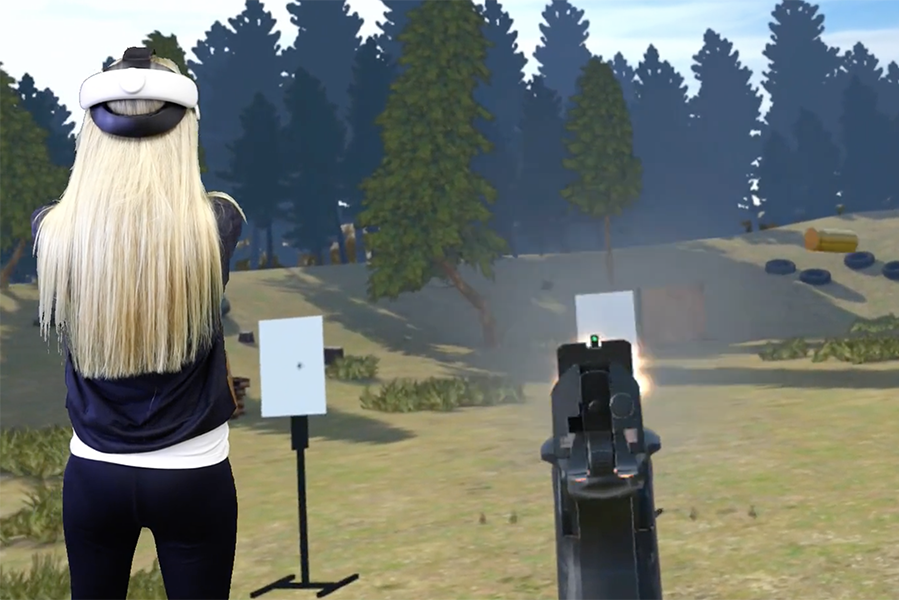
[This is the second of a four-part series on virtual reality training programs. You can read part one here.]
ACE Virtual Shooting (formerly known as ACE XR and previously reviewed here) is a handgun marksmanship and competition simulator for the Meta Quest VR platform. The heart of the ACE system has been their Arctus handset, a 3D printed simulated weapon about the size of a SIG SAUER P320.
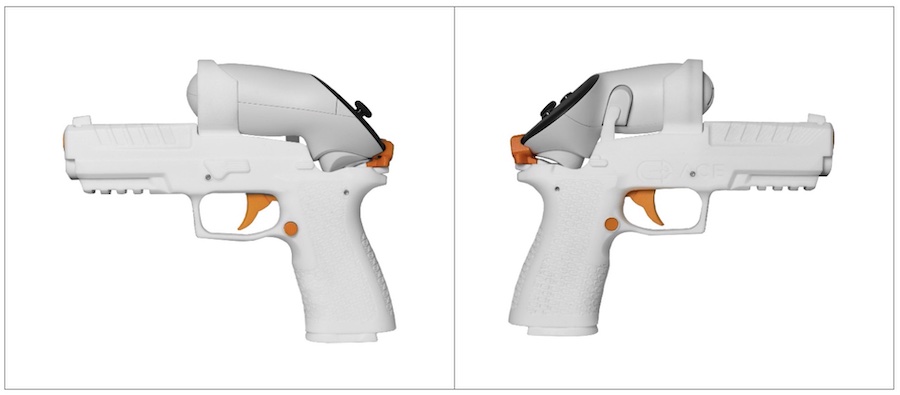
Attached to a Meta Quest controller (which securely snaps into place without tools) and featuring integrated weights in the proper locations, it tips the scales at 29.5 oz. As its designers intended, the weight and balance of the Arctus handset is comparable to an actual firearm.
It’s also built like a tank. ACE Marketing Manager Noah Scinta reports that despite literally tens of millions of virtual rounds being fired from the Arctus handsets to date, there have been zero failures due to normal use.
While the Meta Quest controller is mounted in the “wrong” direction (i.e., instead of being pointed at the target, the mounted controller is pointed 180 degrees around and about 60 degrees down), the ACE software accounts for all of that. However, this mounting system means the ACE handset can’t be used in other Meta Quest apps or games…at least not without some sort of software patch.
What’s extremely clever about the ACE handset is how it handles the trigger, magazine release, and slide release. The ACE handset uses a patent pending fire control group that uses springs, cams, and other connectors to connect the trigger on the handset and the “trigger” button on the right side of the Meta Quest controller.
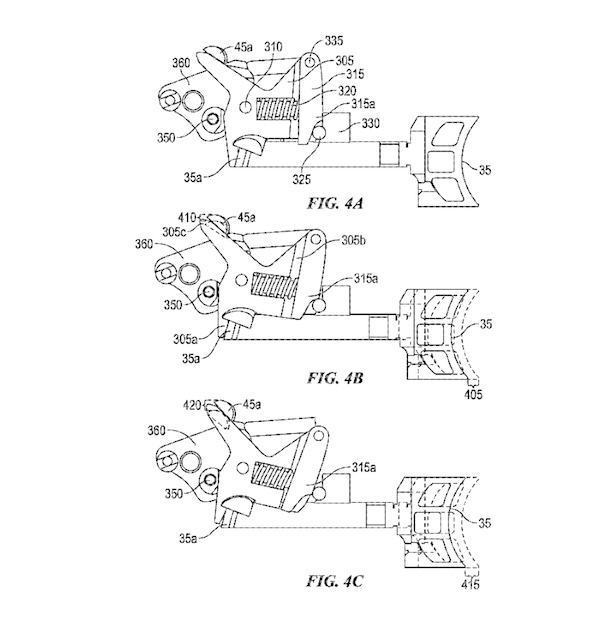
Along with adjustment settings in the software, the system allows the ACE handset to have a 4 to 5 pound trigger pull that feels like an actual handgun trigger – including a break and tactile reset – rather than the toylike feel of the controller’s electronic switch trigger.
The handset’s mag release is similarly connected to the secondary trigger button on the controller which, when pressed, causes the magazine in VR pistol (but not in the actual handset) to drop. Doing a subsequent “tap” of the magazine (a la a tap-rack stoppage drill) is detected by a gyroscope in the controller, and causes a fresh magazine to be loaded in VR and the slide released.
For those who favor a 2011 platform, ACE recently released a handset that’s an authorized clone of the Staccato P 2011.
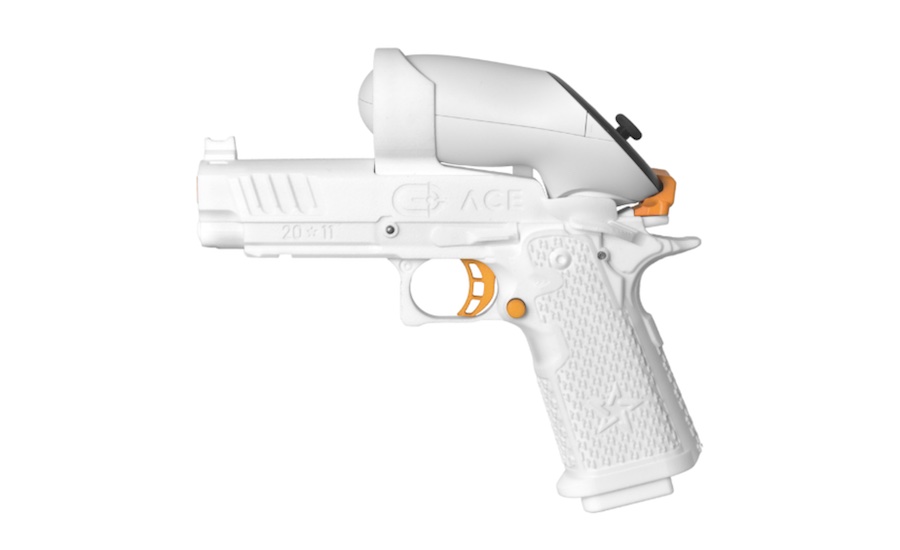
Others in the ACE community are cloning their personal raceguns by 3D-printing (and adding tungsten shot or other weights as needed), and transplanting the fire control group and other moving parts from a donor ACE handset. Some are also tweaking the fire control group to adjust the trigger pull weight, takeup, and break to more closely emulate their particular raceguns, either by tuning the ACE fire control group or by replacing the trigger and sear with modified parts.
ACE’s Noah Scinta reports that a custom ACE holster for the Arctus handset should be available shortly. Holsters for a Staccato P will, of course, work with the ACE handset clone of that pistol.
Once you fire up the Meta Quest and start the program, you can select from a number of available handguns to use in VR (initially a Staccato P, Staccato C2, and ACE 320 (a SIG P320 clone), with a Walther PDP Steel, CZ Shadow 2, and an Open race gun available as you progress.
You also have an array of available red dots (including various models from Shield, Holosun, Delta, and Cyelee) that you can select and mount on your chosen handgun using a virtual armorer’s bench.
Some of these require in-game “purchases” using in-game currency earned from running various drills and from improving your scores. Suffice it to say that if you use it as a regular trainer, you’ll have plenty of in-game currency. You can also choose the nature and terrain of the virtual shooting range you are using (desert, forest, berms, winter).
ACE features an impressive array of handgun scenarios and drills, starting with a basic aiming/sight picture exercise . . .
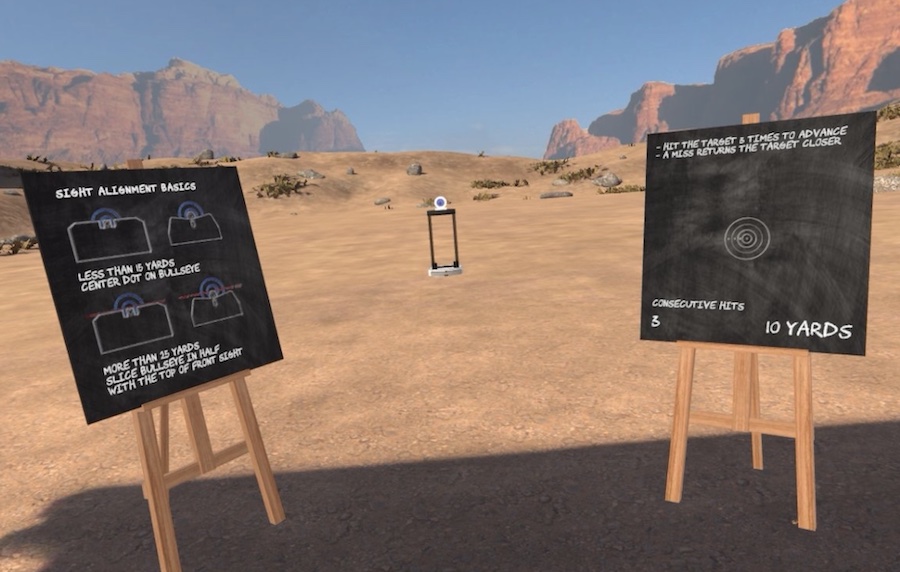
There’s an open plinking range with practically every imaginable range target (other than Tannerite) nicely simulated . . .
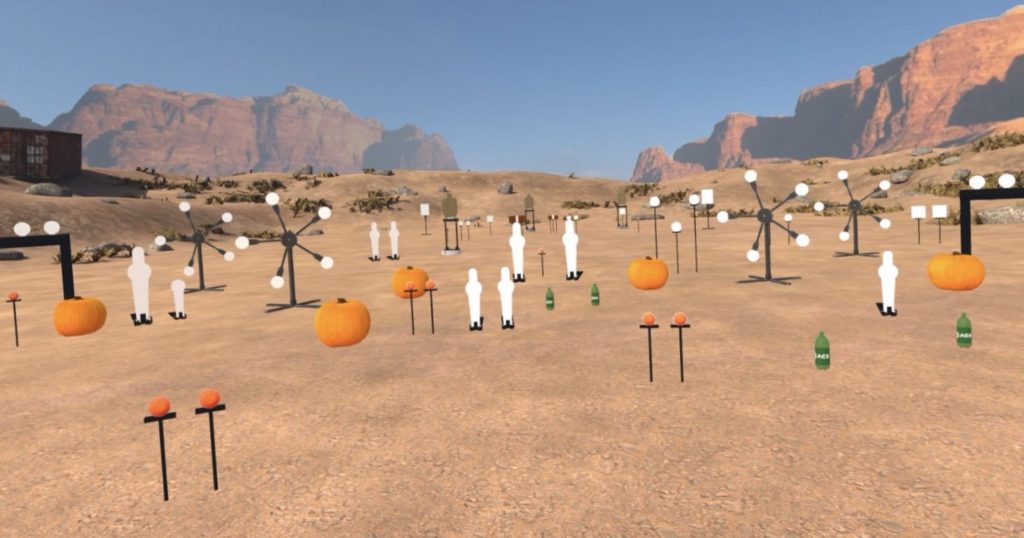
Ther’s also a “whack a mole” exercise involving moving, quickly appearing and disappearing steel targets . . .
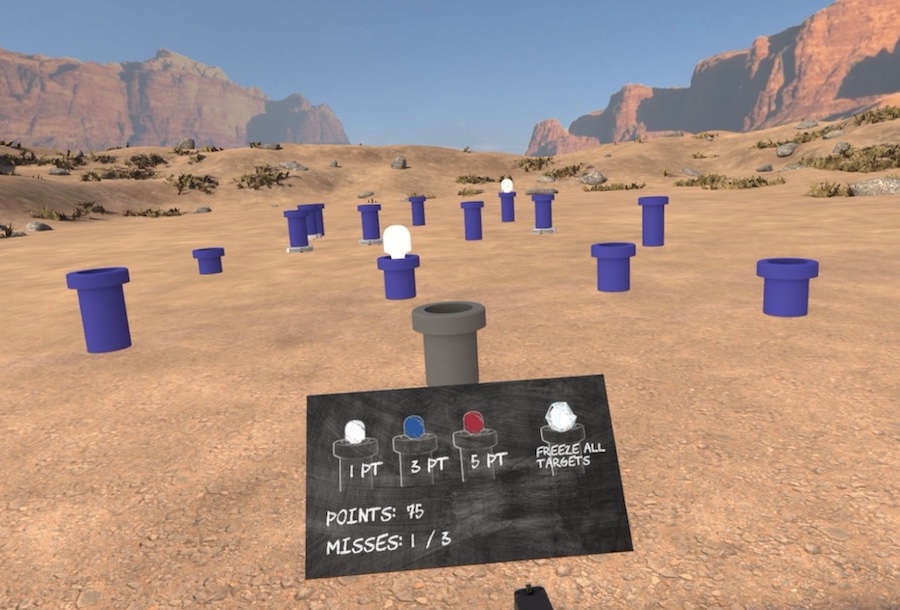
There’s a maddingly fun exercise with steel targets carried by drones that come at you from 360 degrees. There’s also a rather cheesy zombie apocalypse scenario (zombie targets coming at you from 360 degrees, and only headshots stop them), but the less said about that one, the better.
ACE is thus a safe, fun way to teach new shooters fundamentals like stance, grip, sight picture, and trigger press before taking them to the range. The Meta Quest platform allows you to “cast” what the user is seeing in the headset to a tablet or TV, allowing you to see what the user is doing and coach them along.
ACE also features a large variety of practical handgun training drills, such as FAST (Fundamentals, Accuracy, and Speed Test), Mozambique, Jeff Cooper’s “El Presidente,” Bill Wilson’s “Bill Drill,” and many more, all with automatic scoring and split timing displayed when the drill is completed.
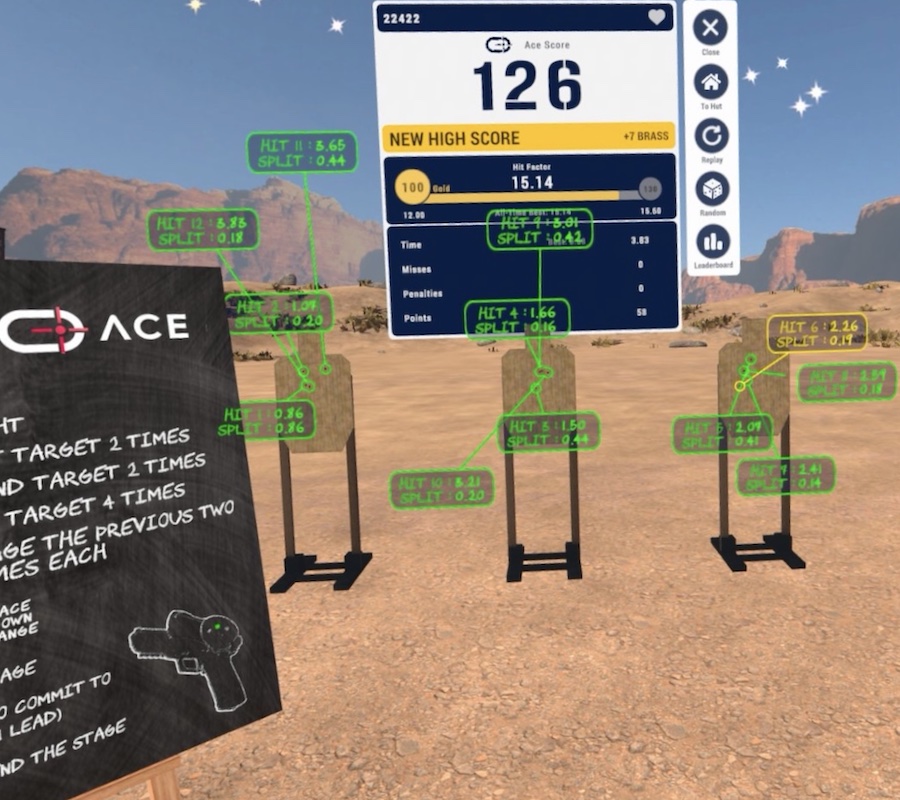
In all of these drills and scenarios, you’re limited to the round capacity of your selected VR pistol and must virtually reload when you’re out (the slide on the VR weapon will show as locked back when you run empty).
You can, of course, do a tactical reload at any time and in many of the stages figuring out the optimal time to do that is important. You can also set the software to give you what amounts to a magazine with infinite capacity, but if you’re using the ACE system for training, why would you?
An excellent skill builder is the Target Acquisition exercise. This one helps develop quick target recognition and practice point-shooting as you have an increasingly short time to identify and double-tap the threat target before the doors close) . . .
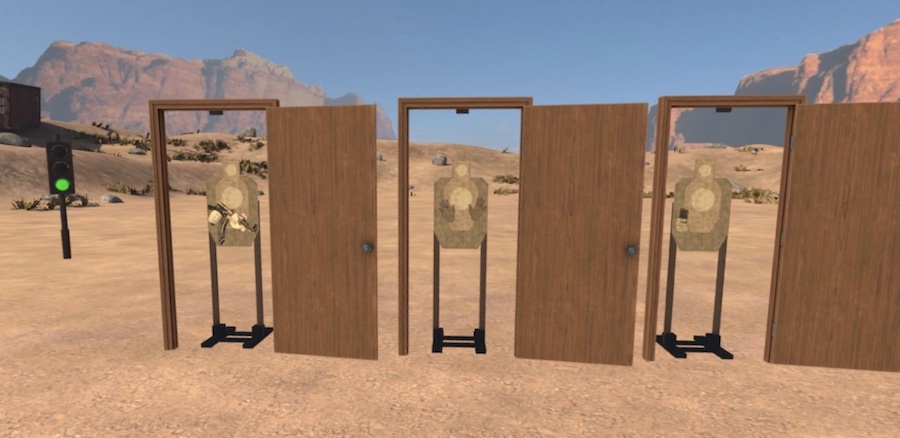
Where ACE really excels, though, is its simulations of practical shooting competitions…IPSC, IDPA, Steel Challenge, and various outlaw stages. It features a wide array of such stages including roomscale ones that require actual footwork and movement with more drills and stages being added every month.
ACE has now officially partnered with the United States Practical Shooting Association (USPSA), and various USPSA classification and official competition stages can now be shot on ACE.
View this post on Instagram
Such stages also include an automated virtual range officer, which will immediately stop the stage and disqualify you for a serious range violation such as breaking the 180 degree rule.
According to ACE’s Noah Scinta, a “sandbox” module is in the works that will allow users to design, run, and share their own stages, and ACE anticipates adding a curated selection of such user-designed stages to the ACE system over time. Indeed, the ACE online community (hosted on the DISCORD platform) is very active and includes almost daily postings and feedback from the ACE developers and marketing honchos, as well as comments by professional instructors like Tim Herron and rabid competitors such as Steel.Challenge.Dude who have been working with the ACE developers to perfect the verisimilitude of the various competition stages. (Unfortunately, like many online communities, it also includes a few trolls with the intellect and maturity of a fourteen-year-old-girl. Caveat emptor.)
How realistic and useful are these virtual stages? A number of competitive shooters in the ACE DISCORD community report replicating and running some of the ACE stages in the real world, and indicate that their times and scores in the virtual and IRL were indeed comparable.Many ACE users report that their scores in actual competitions have improved substantially since they began training on ACE.
Tim Herron, Max Michel, and many other very serious competitive shooters rave about ACE as a training vehicle. Indeed Tim recently posted that since purchasing an ACE system earlier this year, he has fired over 240,000 virtual rounds on it and he’s regularly atop the ACE leaderboards for the various drills and stages.
In my case, over the past year I’ve transitioned from my old reliable G26, which I trained with and carried for over a decade as my EDC, to an FN Reflex MRD with a Shield RMSc optic, so I want to get used to running an optic. Practicing with the ACE system for weeks with the virtual handgun equipped with a similar Shield optic has drastically reduced the times I’m “chasing the dot,” for a lot less money than if I’d practiced at the range.
If online competition is what turns your cranks, there’s an online Discord community of fanatical ACE users waiting for you, as well as leaderboards, levels, trophies, and weekly competitions. But like many aspects of IPSC and IDPA competitions, ACE’s seemingly obsessive focus on competitive leaderboards, rankings and such, could be argued to undercut some of its utility as a practical shooting trainer. However, I demur.
If you want to play it as a game, you certainly can. But if, like me, you’re just not interested in competitions, leaderboards, badges, rankings, or obsessing about shaving 0.01 sec off the best time on a particular stage, you can ignore all of that and find plenty of valuable training – and fun – in ACE, all without having to make a trip to the range.
For example, if you’re satisfied with your performance on a drill/stage/exercise, now try running it with your weak side hand. Or one-handed, strong side. Or one-handed, weak side. Or while moving (after making sure, of course, that you have enough room in the real world that you won’t run into furniture or a wall).
How much is ACE? In addition to having your own Meta Quest 2 ($200) or 3 ($500), you have to purchase an ACE handset ($200), and subscribe to ACE for $19 per month ($14 per month if paid annually…if you later drop your subscription, you’ll still be able to use a limited set of ACE features.) While not as inexpensive as most Meta Quest apps, it’s still downright cheap compared to the price of ammo and range fees.
Are there improvements that could be made to ACE? Of course. In addition to the bespoke ACE holster and the “sandbox” features that are in the works, I’d like to see a utility that allows the user to adjust their VR sight picture to what your muscle memory says it should be. I’d also like to see some realistic judgment training scenarios (dynamic shoot/no shoot situations such as those offered by VirTra, LaserShot, and iMarksman) using 3D human targets, rather than strictly target practice.
However, for now at least, ACE appears laser-focused on perfecting its handgun competition simulations. Going a yard wide and a mile deep like that isn’t a bad business strategy.
For a product that’s been live for less than a year, ACE appears remarkably agile in constantly improving and expanding its product. Indeed, since I started using ACE a couple of months ago, it has already had a serious number of significant upgrades and improvements. And if the scope of ACE’s pending patent application is any indication, expect to see all sorts of cool improvements and enhancements in the future.
Bottom line: if you’re looking for a realistic handgun shooting range and IPSC/IDPA /Steel Challenge simulator, which also has some cool games and exercises not found in the real world, I strongly urge you to check ACE out. Dryfire practice has never been so much fun.


Great article Louis. What we have learned is that really (deadly) serious shooters – the military and LEOs – want the VR gun controller to be their own service weapon. Which is why we are using the Mantis Blackbeard electronic bolt on the kits that we build to train on moving targets. We use a Vive Wrist Tracker on the accessory rail to track the movement of the rifle. As described here : https://www.leadtech.co/vr-marksmanship-simulator-for-robotic-targets/
We have been unable to find an elegant electronic trigger for a shotgun. If we do, we will redo Clazer to use it ! Stay tuned